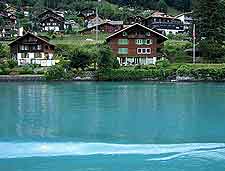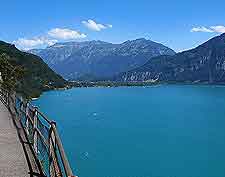Interlaken History Facts and Timeline
(Interlaken, Berne, Switzerland)

Settlements were first present around Interlaken as long ago as the late Stone Age and the Bronze Age, with artefacts from Neolithic times being discovered here in recent years, along with some coins from the days of the Romans. More recently, in the early part of the 12th century, a new settlement was formed, although it is not until 1275 that old documents of history begin to mention this area, particularly the nearby mountain village of Habkern.
Interlaken was named 'Aarmuhle' for many centuries, after the riverside mill, and this name lasted right up until the year of 1891. The town grew up around the Aare River in the 1130s, when an abbey for the Augustinian Canons was erected.
The Interlaken Abbey
The early abbey played an important role in the establishment of the town and it was very much protected by Lothair III, a Holy Roman Emperor. It became central to the local community and some women were living here by the middle of the 13th century.
Interlaken Abbey rose in status and soon ruled over more than 20 surrounding churches, and by the 14th century, roughly 400 people were living here, made up of some 50 monks and priests, with the rest being women and nuns. Weekly markets were soon the order of the day, allowing locals to trade and barter their produce, which included butter, cheese and livestock.
The strict monastic rules were noticeably relaxed during the latter part of the 14th century and the clergy began to witness much infighting and various disputes, which were often violent. Some convents were closed in the 15th century and following the Protestant Reformation of the 1520s, rioting ensued. The days of the abbey were numbered when the Interlaken bailiwick was founded, with the abbey being used for administrative purposes, as well as a temporary hospital, a granary and even as a place to store wine.
Land Quarrels during the 16th, 17th and 18th Centuries
Interlaken (then Aarmuhle) began to dispute ownership of the surrounding woodlands and fields, with nearby Matten claiming rights to this land as well. This endless quarrelling lasted for almost three centuries, despite numerous unsuccessful attempts at mediation. In 1810, the two towns finally agreed to divide the land equally and this long-running dispute ended, marking the start of a more productive and peaceful period of history for Interlaken.

A Surprising Time for Tourism
In the early 19th century, a new trade in tourism was beginning to make itself known, thanks in no small part to the magnificent paintings of regional landscapes being produced at the time by leading Swiss artists, such as Franz Niklaus Konig (1765 to 1832).
First held in 1805, the Unspunnenfest festival celebrated Swiss culture and also helped to put Interlaken on the tourist map. Visitors came from all over Europe in search of mountain air, elegant hotels and spas. Built in 1864, the Victoria Jungfrau Grand Hotel offered the whole package - luxury, uninterrupted mountain views, landscaped grounds and modern amenities.
The Interlaken to Darligen railway line was built in 1872 and was later extended, meaning that the town had never been easier to reach. Hotels quickly sprung up all over the town, with the most desirable boasting views of the Bernese Alps and the Jungfrau summit in particular. A factory for the weaving of wool was opened in the 1920s, following the end of the First World War. However, after the Second World War, it was not until the 1950s that the tourism trade began to slowly recover, when the town started to be used as a base for major international conventions.
The Town Today
Tourism in Interlaken is as strong as it ever was. A walk along the town's main thoroughfare, the Hoheweg, will reveal many appealing gift shops and attractions. A peaceful stroll along the shoreline of Lake Thun is recommended, or perhaps a trip to the summit of the Harder Klum Mountain onboard the funicular railway named the Harderbahn.
For history buffs looking for Swiss heritage, the Tourist Museum of the Jungfrau Region (Touristik Museum der Jungfrauregion) on the Obere Gasse may be of interest. Others simply come here for the cross-country skiing and snowboarding in the winter months.
 Settlements were first present around Interlaken as long ago as the late Stone Age and the Bronze Age, with artefacts from Neolithic times being discovered here in recent years, along with some coins from the days of the Romans. More recently, in the early part of the 12th century, a new settlement was formed, although it is not until 1275 that old documents of history begin to mention this area, particularly the nearby mountain village of Habkern.
Settlements were first present around Interlaken as long ago as the late Stone Age and the Bronze Age, with artefacts from Neolithic times being discovered here in recent years, along with some coins from the days of the Romans. More recently, in the early part of the 12th century, a new settlement was formed, although it is not until 1275 that old documents of history begin to mention this area, particularly the nearby mountain village of Habkern.